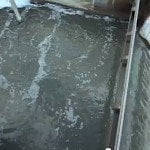Scientists at the National Institute of Standards and Technology developed a way to count the absolute number of neutrons in a beam with unprecedented accuracy. In fact, this new method is four times more accurate than results previously obtained by the group and an astonishingly 50 times more accurate than similar measurements anywhere else in the world. The researchers reported their findings in an article published in Metrologia.
“Our technique is entirely unique,” said Jeffrey Nico, a physicist at the National Institute of Standards and Technology (NIST). “Nobody else has this capacity.”

The team’s method involves an alpha-gamma apparatus built at NIST, as well as an exacting, multi-stage process that results in final measurement uncertainties of 0.058 per cent. Determining the number of neutrons moving within a beam per unit of time is necessary for a variety of applications, such as nuclear power management.
Typically, measuring the rate of neutron flux involves aiming the beam at a target and counting the number and kinds of products emitted when the neutrons interact with atoms in the target. Although the process is pretty straightforward, counting emissions is not enough. The cross section also comes into place and is different for each element. It also differs across neutron energies and a variety of other factors. The cross section is generally obtained through database tables of world average values, though this does not provide a great deal of accuracy.

The new method developed by the NIST researchers aims to solve that problem and avoid dependence on outside sources and estimated values. The method uses information that is directly measurable by scientists. “Before, we had to get values from elsewhere,” said project scientist M. Scott Dewey. “For example, in the case of the neutron lifetime, every time the database revises its numbers, our lifetime measurement changes because it tracks those numbers. Now we don’t have to rely on databases, or cross sections, or branching ratios, etc. The new approach uses the constancy of these fundamental interactions to turn it into a counting experiment.”
The process consists of four stages, the first of which includes utilizing the alpha-gamma device to detect alpha particles and gamma rays. The scientists place a radioactive alpha particle source with an emission rate that is known to within a few hundredths of a per cent in the device, which will provide a reading so as to calibrate the alpha detectors. From there, the scientists move on to the second stage, which involves calibrating the gamma detectors by placing a thin target comprised of boron-10 in the chamber. A beam hits the target, causing it to emit both alpha particles and gamma-ray photons.
In the third stage, the boron-10 target is replaced by a thick piece of boron carbide, which will absorb the neutrons upon impact. While some alpha particles will remain, highly energetic gamma rays will be released and the gamma count can be used as an accurate measure of the neutron flux.
The final stage of the process involves calibrating a neutron flux monitor using the rate which was measured by the alpha-gamma device. The monitor sits in the neutron beam line and absorbs one per cent of the neutrons. The device then absorbs the other 99 per cent.

“This way of measuring things just didn’t exist before,” said Dewey. “Because nobody in the world has the capability to do it, we only have our own word that the thing really works. That’s kind of scary. We’d like to have the community check us on this.”
The new method will play a vital role in nuclear metrology, and scientists were able to validate the findings by comparing the results of a cross section that is already well known to its pre-determined values. According to project scientist Hans Pieter Mumm, the team plans to conduct a preliminary measurement of uranium-235 and cross-check the values. “The U-235 cross section is known to great precision. Not only will that demonstrate the capabilities of our technique, but it could open up an entirely new way of verifying the values in standard cross-section databases.”

































